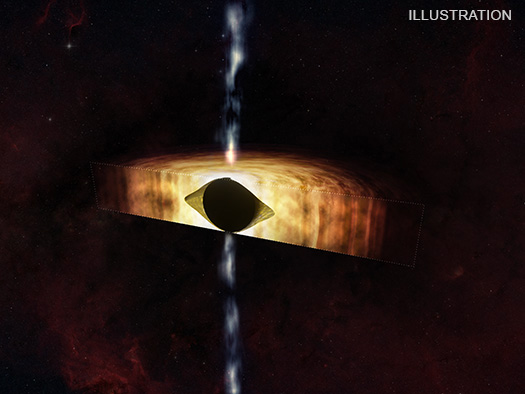For Release: February 8, 2024
NASA/CXC
The supermassive black hole in the center of the Milky Way is spinning so quickly it is warping the spacetime surrounding it into a shape that can look like a football, according to a new study using data from NASA’s Chandra X-ray Observatory and the National Science Foundation’s Karl G. Jansky Very Large Array (VLA).
Astronomers call this giant black hole Sagittarius A* (Sgr A* for short), which is located about 26,000 light-years away from Earth in the center of our galaxy.
Black holes have two fundamental properties: their mass (how much they weigh) and their spin (how quickly they rotate). Determining either of these two values tells scientists a great deal about any black hole and how it behaves.
A team of researchers applied a new method that uses X-ray and radio data to determine how quickly Sgr A* is spinning based on how material is flowing towards and away from the black hole. They found Sgr A* is spinning with an angular velocity — the number of revolutions per second — that is about 60% of the maximum possible value, a limit set by material not being able to travel faster than the speed of light.
In the past, different astronomers made several other estimates of Sgr A*’s rotation speed using different techniques, with results ranging from Sgr A* not spinning at all to it spinning at almost the maximum rate.
“Our work may help settle the question of how fast our galaxy’s supermassive black hole is spinning,” said Ruth Daly of Penn State University, who is the lead author on the new study. “Our results indicate that Sgr A* is spinning very rapidly, which is interesting and has far reaching implications.”
A rotating black hole pulls “spacetime” (the combination of time and the three dimensions of space) and nearby matter around as it spins. Spacetime around the spinning black hole is also squashed down. Looking down on a black hole from the top, along the barrel of any jet it produces, spacetime is a circular shape. Looking at the spinning black hole from the side, however, the spacetime is shaped like a football. The faster the spin the flatter the football.
A black hole’s spin can act as an important source of energy. Spinning supermassive black holes can produce collimated outflows, that is narrow beams of material such as jets, when their spin energy is extracted, which requires that there is at least some matter in the vicinity of the black hole. Because of limited fuel around Sgr A*, this black hole has been relatively quiet in recent millennia with relatively weak jets. This work, however, shows that this could change if the amount of material in the vicinity of Sgr A* increases.
“A spinning black hole is like a rocket on the launch pad,” said Biny Sebastian, a co-author from the University of Manitoba in Winnipeg, Canada. “Once material gets close enough, it’s like someone has fueled the rocket and hit the ‘launch’ button.”
This means that in the future, if the properties of the matter and the magnetic field strength close to the black hole change, part of the enormous energy of the black hole’s spin could drive more powerful outflows. This source material could come from gas or from the remnants of a star torn apart by the black hole’s gravity if that star wanders too close to Sgr A*.
“Jets powered and collimated by a galaxy’s spinning central black hole can profoundly affect the gas supply for an entire galaxy, which affects how quickly and even whether stars can form,” said co-author Megan Donahue from Michigan State University. “The ‘Fermi bubbles’ seen in X-rays and gamma rays around our Milky Way’s black hole show the black hole was probably active in the past. Measuring the spin of our black hole is an important test of this scenario."
To determine the spin of Sgr A*, the authors used an empirically based theoretical method referred to as the “outflow method” that details the relationship between the spin of the black hole and its mass, the properties of the matter near the black hole, and the outflow properties. The collimated outflow produces the radio waves, while the disk of gas surrounding the black hole is responsible for the X-ray emission. Using this method, the researchers combined data from Chandra and the VLA with an independent estimate of the black hole’s mass from other telescopes to constrain the black hole’s spin.
“We have a special view of Sgr A* because it is the nearest supermassive black hole to us,” said co-author Anan Lu from McGill University in Montreal, Canada. “Although it's quiet right now, our work shows that in the future it will give an incredibly powerful kick to surrounding matter. That might happen in a thousand or a million years, or it could happen in our lifetimes.”
The paper describing these results led by Ruth Daly is published in the January 2024 issue of the Monthly Notices of the Royal Astronomical Society and appears online at https://ui.adsabs.harvard.edu/abs/2024MNRAS.527..428D/abstract. In addition to those mentioned above, the authors are Christopher O’Dea (University of Manitoba), and Daryl Haggard (McGill University).
NASA's Marshall Space Flight Center manages the Chandra program. The Smithsonian Astrophysical Observatory's Chandra X-ray Center controls science operations from Cambridge, Massachusetts, and flight operations from Burlington, Massachusetts.
Media Contact:
Megan Watzke
Chandra X-ray Center, Cambridge, Massachusetts
617-496-7998
mwatzke@cfa.harvard.edu
Jonathan Deal
Marshall Space Flight Center, Huntsville, Alabama
256-544-0034
jonathan.e.deal@nasa.gov



